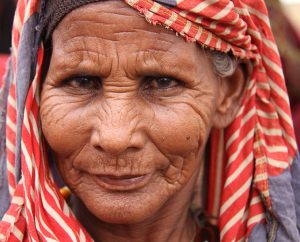36 Older People Around the World
Old people in Canada and the US
A relatively greater percentage of us are older people than in the past—not only in Canada, and the U.S. Estimates from the 2016 census suggest that 17.2% of the Canadian population was 65 and older as of July 1, 2018, while only 14.4% was in this range 7 years earlier (Statistics Canada, January 25, 2019). In the the U.S, those 65 and up make up the largest age group (Gatz, Smyer, & DiGilio, 2016). Currently, one in seven Americans is 65 years of age or older. The first of the baby boomers (born from 1946-1964) turned 65 in 2011. OECD (2017) data indicates that in 2015 a 65-year-old Canadian could expect to live 20.2 more years, while a 65-year-old American could expect to live 19.3 more years.
Table 6.36.1 shows the 2012, 2020, and 2030 projected percentages of the U.S. population ages 65 and older.
| 2012 | 2020 | 2030 | |
| 65 years and older | 13.7% | 16.8% | 20.3% |
| 65-69 | 4.5% | 5.4% | 5.6% |
| 70-74 | 3.2% | 4.4% | 5.2% |
| 75-79 | 2.4% | 3.0% | 4.1% |
| 80-84 | 1.8% | 1.9% | 2.9% |
| 85 years and older | 1.9% | 2.0% | 2.5% |
Globally a bigger percentage of us are older.
The average ages in the United States and Canada are the lowest and second-lowest in the G7 countries, which also include France, Japan, Germany, Italy, and the United Kingdom (Statistics Canada, 2019 ).
| 2012 | 2030 | 2050 | |
| Japan | 24% | 32.2% | 40% |
| Italy | 20% | 25.5% | 31% |
| Germany | 20% | 27.9% | 30% |
| Canada | 16.5% | 25% | 26.5% |
| United States | 13.7% | 20.3% | 22% |
| Russia | 13% | 20% | 26% |
According to the National Institute on Aging (NIA, 2015b), there are 524 million people over 65 worldwide. This number is expected to increase from 8% to 16% of the global population by 2050. Between 2010 and 2050, the number of older people in less developed countries is projected to increase more than 250%, compared with only a 71% increase in developed countries. Declines in fertility and improvements in longevity account for the percentage increase for those 65 years and older. In more developed countries, fertility fell below the replacement rate of two live births per woman by the 1970s, down from nearly three children per woman around 1950. Fertility rates also fell in many less developed countries from an average of six children in 1950 to an average of two or three children in 2005. In 2006, fertility was at or below the two-child replacement level in 44 less developed countries (NIA, 2015d).

In absolute numbers, the United States is projected to have a larger older population than Canada and the other developed nations, but a smaller older population compared with China and India, the world’s two most populous nations (Ortman et al., 2014).
The increased number of us who are or will be older confers both challenges and gifts. On one hand there will be a large number of people with advanced skills and knowledge ready to help build momentum for further innovation. On the other hand inevitably there also will be a greater absolute number of people needing assistance with age-associated illness and disability on a long-term basis and relatively fewer family members to assist due to decreased fertility rates. Older people and family members will call on the resources and sense of justice in the society around them to create the processes and supports which permit people of all ages to participate fully in society. Society may call upon those of us who are older and healthy to help age peers and younger people with temporary or permanent work limitations. Innovators may result in technologies that are good for all of us.
Media Attributions
- 085-OlderWoman © Trocaire is licensed under a CC BY (Attribution) license

